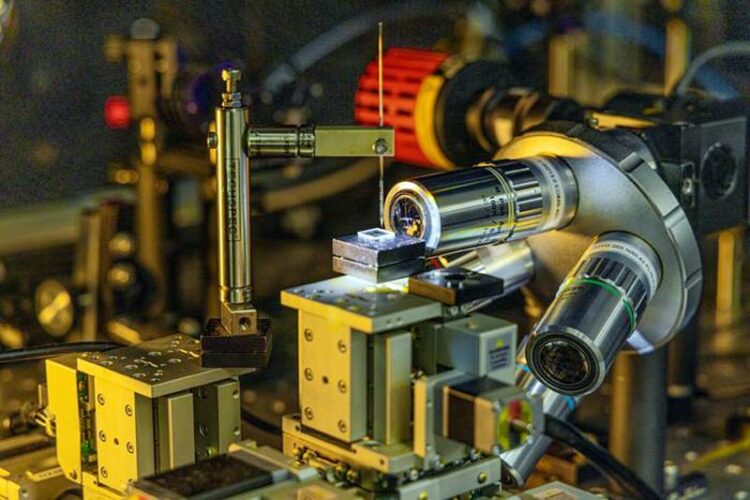Three-dimensional printing achieves precision light control for structural coloration

Nano photonic 3D printer used for manufacturing diffraction grating for advanced displays
Credit: Korea Electrotechnology Research Institute
Dr. Jaeyeon Pyo’s team at KERI developed a method for printing structural colors through nanoscale 3D printing of diffraction gratings, selected as a cover article for ACS Nano.
The world’s first 3D printing technology that can be used in transparent displays and AR devices has been developed, which implements the physical phenomenon of chameleon’s changing skin color or peacock’s beautiful feather color.
Dr. Jaeyeon Pyo’s team at KERI has succeeded in realizing a three-dimensional diffraction grating that can precisely control the path of light based on ‘nanoscale 3D printing technology’. This is a novel technology that can utilize the principle of structural color observed in nature for advanced display technology.
When light encounters a microstructure at the wavelength level (1/100 to 1/1000 of the thickness of a human hair), it diffracts* and changes its path. In cases where the microstructure possesses reularity, specific wavelengths of light undergo strong reflection due to diffraction, resulting in distinct colors known as ‘structural color’. For instance, in nature, the skin color of chameleons doesn’t arise from a mixture of multiple pigments; rather, it emerges from changes in the microstructure, which lead to the production of structural colors. Similarly, the beautiful colors seen in peacock feathers are a result of the specific arrangement of their internal microstructure.
* Diffraction: A phenomenon in which light bends or spreads widely through a hole (gap) when it encounters an obstacle.
KERI’s achievement is the realization of ‘diffraction grating’, which can precisely control structural color, with nanoscale 3D printing technology. A diffraction grating is a device with a regularly arranged microstructure for the purpose of controlling the diffraction of light. When light is shined on it, the light is reflected in different paths depending on the wavelength, creating a specific structural color or spectrum. In other words, it is a 3D printing technology that enables precise control of light for vivid coloration without dyes.
A very fine diffraction grating is needed to control the diffraction of light whose wavelength is only 1/1000th the thickness of a human hair. KERI, which has the world’s best nanoscale 3D printing technology, succeeded in printing high-density nanowire diffraction gratings with a new approach called ‘lateral printing’. This is done by moving the 3D printing nozzle as if it were sewing to print the bridge shape(﹇).
The demonstrated diffraction grating is expected to be used in a variety of advanced display applications. Noting the transparency of the diffraction grating itself, it can be used in a variety of future transparent displays such as smart windows, mirrors, and heads-up displays in automobiles. There are also many applications for this technology in AR devices that already utilize diffraction gratings as a key component. Furthermore, diffraction gratings can be designed to emit different colors depending on their deformation, making the technology usable in mechanical engineering and biomedical applications where deformation detection is required, and the diffraction grating itself can be used in a variety of optical physics research.
Dr. Jaeyeon Pyo of KERI said that this is “the world’s first 3D printing technology that accurately implements the desired structural color in the desired location without restrictions on the material or shape of the substrate.” He added that this technology will be able to overcome the formulaic ‘Form-Factor’ limitations of display devices and bring about diversification of shapes.
The research was recognized for its excellence and published as a cover article in ACS Nano, a top-tier SCI journal in materials science published by the American Chemical Society. The JCR Impact Factor, which measures the impact of a journal, is 17.100, placing it in the top 5.7% of its field.
KERI, which has completed the patent application of the original technology, expects this achievement to receive a lot of attention from display-related companies, and plans to promote technology transfer by identifying companies that need this technology.
Meanwhile, KERI is a government-funded research institute under the National Science and Technology Research Council of the Ministry of Science and ICT. This research was developed through KERI’s basic project, ‘Development of 4D printing technology for circuit/housing integrated devices’. Dr. Jaeyeon Pyo is also an adjunct associate professor at the University of Science and Technology (UST). <KERI>
Journal: ACS Nano
DOI: 10.1021/acsnano.3c02236
Article Title: Three-dimensional Printing of Structural Color using a Femtoliter Meniscus
Article Publication Date: 25-Jul-2023
All latest news from the category: Physics and Astronomy
This area deals with the fundamental laws and building blocks of nature and how they interact, the properties and the behavior of matter, and research into space and time and their structures.
innovations-report provides in-depth reports and articles on subjects such as astrophysics, laser technologies, nuclear, quantum, particle and solid-state physics, nanotechnologies, planetary research and findings (Mars, Venus) and developments related to the Hubble Telescope.
Newest articles

Innovative 3D printed scaffolds offer new hope for bone healing
Researchers at the Institute for Bioengineering of Catalonia have developed novel 3D printed PLA-CaP scaffolds that promote blood vessel formation, ensuring better healing and regeneration of bone tissue. Bone is…

The surprising role of gut infection in Alzheimer’s disease
ASU- and Banner Alzheimer’s Institute-led study implicates link between a common virus and the disease, which travels from the gut to the brain and may be a target for antiviral…

Molecular gardening: New enzymes discovered for protein modification pruning
How deubiquitinases USP53 and USP54 cleave long polyubiquitin chains and how the former is linked to liver disease in children. Deubiquitinases (DUBs) are enzymes used by cells to trim protein…


